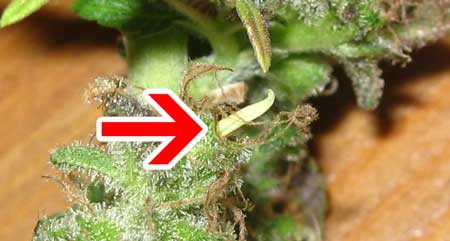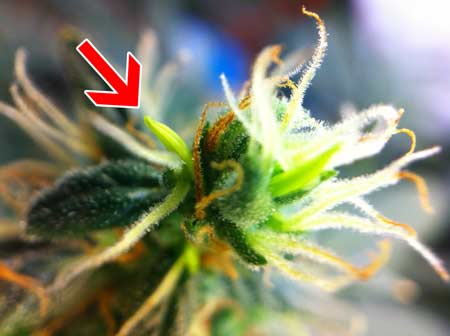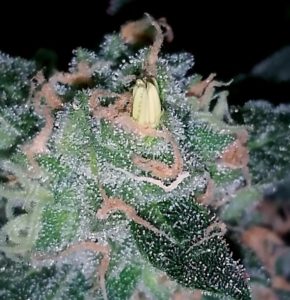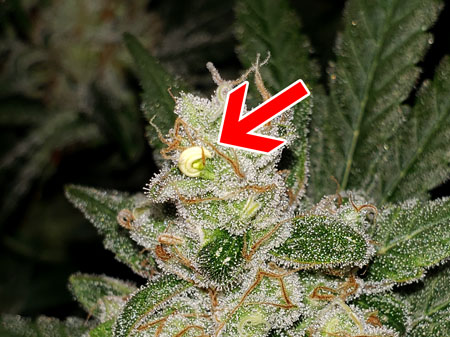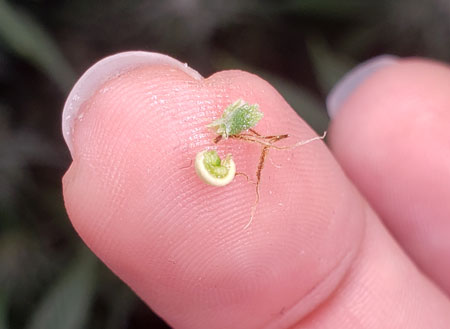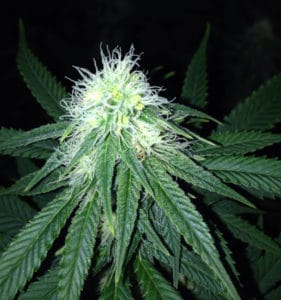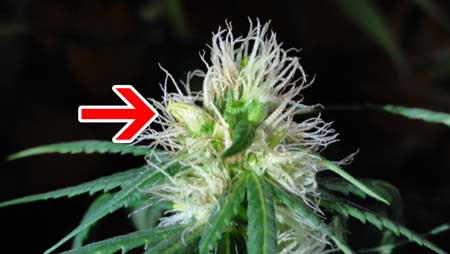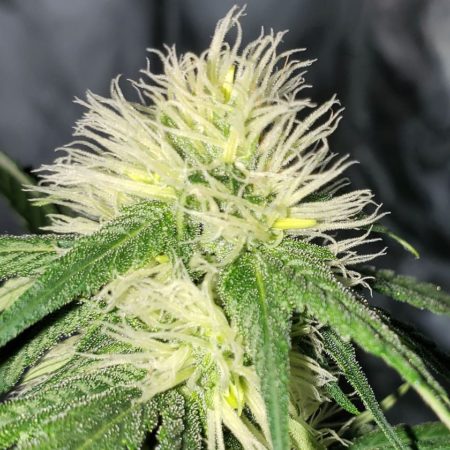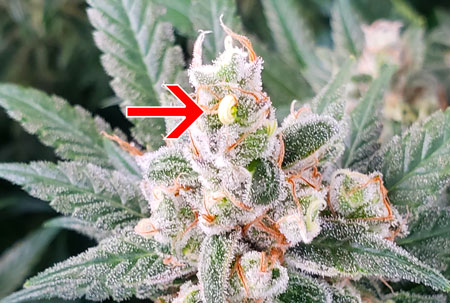by Nebula Haze
Bananas or “nanners” are a type of mixed-sex cannabis flower that grow from the middle of cannabis buds as a result of stress or genetics.
Example of a “Banana” or “Nanner” growing among cannabis buds
Bananas are unwelcome in cannabis gardens because they release pollen that can cause developing buds to form seeds. One or two bananas probably won’t make a whole lot of seeds, but many of them can produce very seedy buds. The earlier they appear in the flowering stage and the more time bananas get to release pollen, the more seeds after harvest. Bananas are essentially a last-ditch attempt by the plant to make seeds for the next generation.
Plants with bananas are sometimes called “hermies” or “herms” (shortened from “hermaphrodite”). Learn about other types of herms besides bananas (such as pollen sacs).
Bananas can appear straight or curved. They’re elongated yellow growths which may grow together in bunches like actual bananas. Sometimes they appear white or lime green instead of yellow.
Sometimes a banana appears lime green instead of yellow
Bananas start pollinating everything in the area as soon as they appear. If you have a major banana problem it may be best to harvest the plants immediately and cut your losses. Seeds take some time to develop, so if a plant starts herming right around harvest time, you’re much less likely to end up with seeds. However, if they appear at the beginning of the flowering stage with plenty of time for seeds to fully form, you may find tons of seeds falling out of your buds after harvest.
They can appear in bunches just like real bananas
What are they? Bananas are essentially the exposed “male” parts of a pollen sac, called the stamen, which would normally be surrounded by a sac to hold all the pollen until it bursts open. If you open up a fully formed male pollen sac, you will see what looks like bananas (stamens) inside. Learn more about male vs female cannabis plants.
Unlike pollen sacs, bananas don’t need to burst open to spread pollen. They immediately start seeding buds that are close by. The pollen can drift to nearby plants and pollinate them as well.
This banana appeared a few days after the grower used the bud back building technique (they cut off the top tip of buds to try to get them to grow more fat and round). Apparently, the plant felt attacked
This is what it looked like after being picked off
It’s possible that the pollen is sterile, and won’t pollinate bud successfully… but don’t rely on that happening!
The yellow bunches in this bud are bananas/stamens and will “try” to pollinate everything they can – they don’t have to wait for a pollen sac to burst. It’s possible that the pollen is sterile, but often you may find seeds.
New cannabis buds look like a bunch of white hairs. If you notice yellow on parts of your buds, make sure to look closer!
When a female cannabis plant is allowed to live past the point of harvest, it may produce bananas as a last-ditch attempt to self-pollinate and create seeds for the next year. This is sometimes known as rhodelization. This is not as destructive as other types of hermies since it happens after plants are already past the point of optimal harvest.
What causes bananas? Genetics decide whether a plant is capable of producing bananas, but environmental stress is often the trigger. Even if you do stress your plants, you are much less likely to run into bananas if you stick with high-quality genetics. even if you do accidentally stress your plants.
Yellow banana growing among the beautiful buds ?
What type of stress can trigger bananas to form on cannabis buds?
Inconsistent Light Schedules & Light Leaks – For example when plants don’t get light at the same time each day, or if they’re exposed to light during their dark period (light leak). For photoperiod plants, this might be the most common contributor to hermies.
Temperature – Heat is a common factor. When temps get too high, hermies and nanners often appear. Freezing cold nights (or large temperature swings in general) can also trigger bananas for some strains.
Too-Bright Light – Like too much heat, light stress can trigger hermies. This is often caused by growers keeping grow lights too close to plants. You can light-burn your plants even when the temperature is just right.
Major Plant Problems – Major plant problems like nutrient deficiencies, root rot, pH problems, light-burn and nutrient burn can all trigger nanners to start growing.
Genetics – While stress plays a big role in the formation of bananas, the tendency to form them is genetic. Some strains will never make bananas even in the most stressful growing conditions, while other plants may herm at the tiniest provocation. The tendency to herm is often found in the seeds of a plant that hermed. If you find seeds in buds as the result of bananas, the resulting seeds are more likely to form bananas themselves. “Feminized” seeds come from a process of induced herming, so it’s important to only purchase feminized seeds from a trusted breeder to make sure your plants don’t herm in normal conditions.
What should the grower do? It is recommended that you remove plants showing bananas from your grow area immediately to prevent accidental pollination of buds.
If bananas appear while buds are still white and fluffy, remove the plant from the grow room immediately. It will only get worse.
Brown pistils/hairs next to the bananas on otherwise white buds have already been pollinated. Don’t wait to toss this plant!
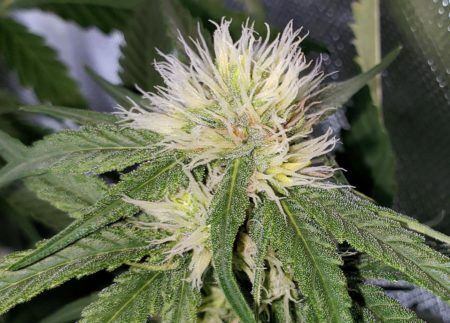
A grower who watches very closely can carefully pluck all bananas, especially if you only see them right near harvest time. At that point, any seeds wouldn’t have a lot of time to develop anyway. But plucking bananas is unlikely to be successful the earlier you see them. If you’re already seeing bananas early in the flowering stage, I highly recommend tossing the plant as it will only get worse, and the seeds will steal energy from the buds throughout the flowering stage.
- If bananas appear on any plant early in the flowering stage, toss that plant immediately as it will only get worse, and you don’t want other plants to get pollinated
- If the first bananas appear when harvest is only a week or two away, you probably can probably get away with plucking them on sight as any seeds won’t have time to develop anyway. Or simply harvest a little early.
Be Kind to Yourself. Don’t beat yourself up if you find bananas. It happens to every grower and now you know what to do so you’re prepared for next time.
Although heavily seeded buds tend to be less potent and yields take a hit, a few seeds won’t hurt anything. Everyone occasionally finds a seed or two in their buds, and those buds can still be great!

